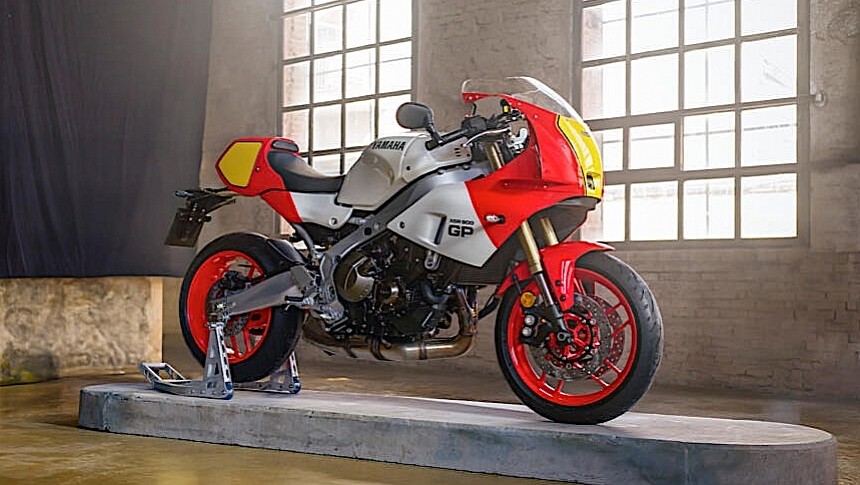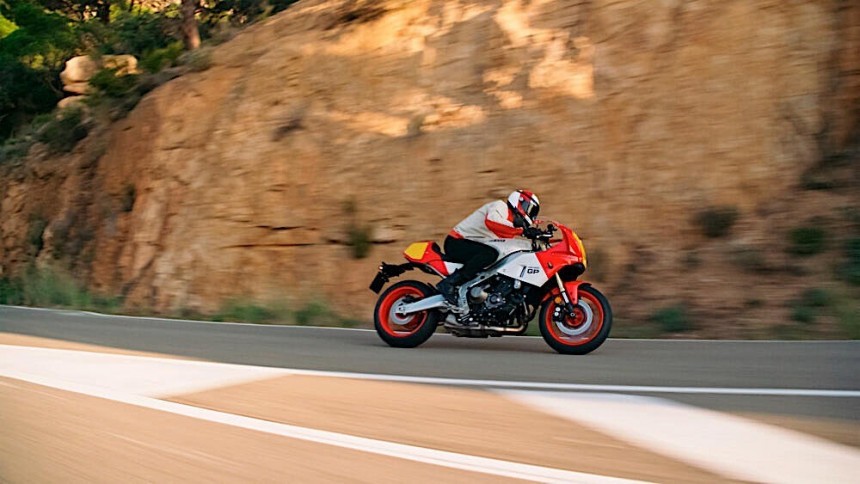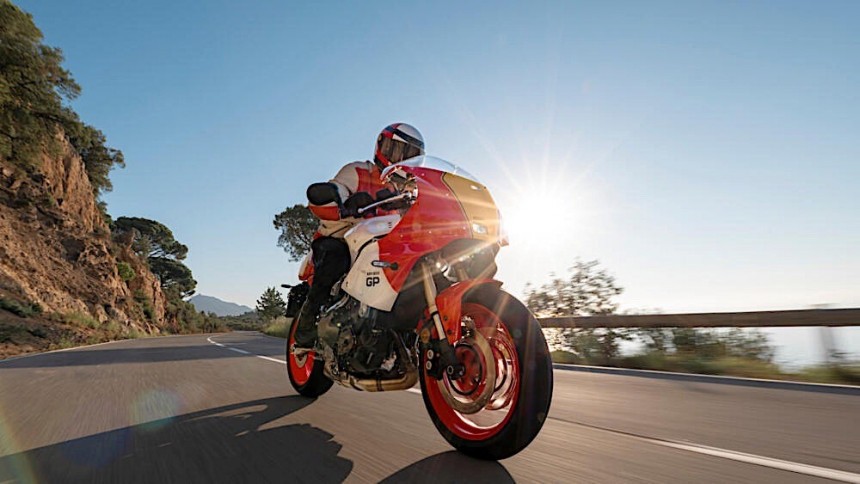Whenever a new motorcycle is launched in our day and age, expectations are very high. Not only when it comes to the way the bike handles and how much power it releases, but also in terms of design: it has to be fresh, exciting, and even daring. The 2024 Yamaha XSR900 GP is anything but, yet exciting nonetheless.
The XSR900 was introduced by the Japanese bike maker in 2016, and it has always played the game in the neo-retro standard segment. It means that despite being modern underneath, it has always placed a bet on old-school looks to be impressive.
No matter how many versions of the bike Yamaha has released since, none have been so 1980s-looking as the GP. And that's a choice the company made on purpose, and seems very proud of.
You see, there is a range of bikes in the bike maker's portfolio called Sport Heritage. It's a collection of bikes meant to pay tribute to "the most iconic motorcycles from Yamaha's rich history."
At the time of writing there are four models in this lineup, namely the Bolt R-Spec, XSR900, XSR700, and V Star 250. The XSR900 GP will become the fifth for the 2024 model year, and comes across as the most extreme of them all.
The bike is not retro only on a declarative level, but really puts its money where the mouth is. Just look at the thing, and the extensive bodywork immediately sends you back to the 1980s, to a time when Yamaha was a household name the king of Grand Prix.
Yamaha calls that decade its Golden Era of racing, and has bikes such as the YZR500 and riders like Kenny Roberts to thank for that. In a few short years, man and machine landed the company no less than three consecutive titles. It also won six Grand Prix titles in the 500cc class between 1984 and 1992.
Many of today's Yamaha bikes, including the XSR900 GP, use a type of frame called the Deltabox, and that too was born back in the 1980s.
We gave all of the above details in a bid to explain why Yamaha is going so off-script with this motorcycle. And we could clearly add to that the fact the GP looks simply amazing in this guise in a time when all motorcycles strive to be revolutionary.
We'll start with the elements that bring forth all that 1980s Grand Prix nostalgia, and those are, of course, the bits and pieces of the bodywork.
It seems like the manufacturer cut no corners in trying to bring back long-gone vibes. If you really think about it, though, it only took the fitting of some skin at the front, modifications at the rear, and some paint, to get the desired effect.
The front end of the two-wheeler is where all the magic happens. There, we're treated to a retro-looking fairing with a small windscreen on top. The thing wraps around the entire upper part of the bike, concealing the handlebars, but also the headlight. This piece is a lens module one, not an LED, tucked away deep inside the fairing.
The piece seemingly dissolves into the frame through a tubbed structure and brackets. At the rear, the bike shows a boxy tush that also hides the light fitted there.
To make sure nobody misunderstands the message the bike is trying to send, Yamaha will go for just two paint jobs for the ride, namely Legend Red and Power Grey. The former set of clothing is the most spectacular, especially when mixed with yellow number boards and patches of white.
Both liveries, we're told, are supposed to remind one of the motorcycles ridden by racing legend Wayne Rainey, and are topped by a colour-matched seat cover.
It may look out of place in 2023, but mechanically speaking the 2024 Yamaha XSR900 GP is more than suited for whatever task its riders have in store for it.
The bike uses the same 890cc CP3 engine as on the regular XSR900, with the same power levels: 106 hp and 63.5 lb.-ft. of torque. The engine helps spin Yamaha-made SpinForged wheels of undisclosed size, both of them wrapped in Bridgestone Battlax Hypersport S23 tires.
The suspension system installed to support the wheels is of the fully adjustable upside-down fork variety at the front and link type at the rear. Brembo braking hardware is on deck to help with stopping power.
The riding position on the GP is slightly different than on the regular XSR900, and that's because the clip-on handlebars move the rider forward for a sportier stance. At the other end, adjustable footrests further emphasize the effect.
There are several new pieces of tech and features the GP brings to the table. It's got a new 5-inch TFT display with integrated Garmin StreetCross navigation system, smartphone connectivity, and a new handlebar switch to control the bike's non-riding-related functions.
The GP has also been fitted with the new Emergency Stop Signal (ESS) that automatically engages the hazard lights when sudden braking power is applied. The bike is also the first Sport Heritage model to come with the third-gen quick shift system.
Yamaha did not announce a specific roll-out date for the XSR900 GP, and says pricing info is available at dealers. For reference, keep in mind the non-GP version of the bike sells from $10,199.
No matter how many versions of the bike Yamaha has released since, none have been so 1980s-looking as the GP. And that's a choice the company made on purpose, and seems very proud of.
You see, there is a range of bikes in the bike maker's portfolio called Sport Heritage. It's a collection of bikes meant to pay tribute to "the most iconic motorcycles from Yamaha's rich history."
At the time of writing there are four models in this lineup, namely the Bolt R-Spec, XSR900, XSR700, and V Star 250. The XSR900 GP will become the fifth for the 2024 model year, and comes across as the most extreme of them all.
The bike is not retro only on a declarative level, but really puts its money where the mouth is. Just look at the thing, and the extensive bodywork immediately sends you back to the 1980s, to a time when Yamaha was a household name the king of Grand Prix.
Yamaha calls that decade its Golden Era of racing, and has bikes such as the YZR500 and riders like Kenny Roberts to thank for that. In a few short years, man and machine landed the company no less than three consecutive titles. It also won six Grand Prix titles in the 500cc class between 1984 and 1992.
Many of today's Yamaha bikes, including the XSR900 GP, use a type of frame called the Deltabox, and that too was born back in the 1980s.
We'll start with the elements that bring forth all that 1980s Grand Prix nostalgia, and those are, of course, the bits and pieces of the bodywork.
It seems like the manufacturer cut no corners in trying to bring back long-gone vibes. If you really think about it, though, it only took the fitting of some skin at the front, modifications at the rear, and some paint, to get the desired effect.
The front end of the two-wheeler is where all the magic happens. There, we're treated to a retro-looking fairing with a small windscreen on top. The thing wraps around the entire upper part of the bike, concealing the handlebars, but also the headlight. This piece is a lens module one, not an LED, tucked away deep inside the fairing.
The piece seemingly dissolves into the frame through a tubbed structure and brackets. At the rear, the bike shows a boxy tush that also hides the light fitted there.
To make sure nobody misunderstands the message the bike is trying to send, Yamaha will go for just two paint jobs for the ride, namely Legend Red and Power Grey. The former set of clothing is the most spectacular, especially when mixed with yellow number boards and patches of white.
Both liveries, we're told, are supposed to remind one of the motorcycles ridden by racing legend Wayne Rainey, and are topped by a colour-matched seat cover.
The bike uses the same 890cc CP3 engine as on the regular XSR900, with the same power levels: 106 hp and 63.5 lb.-ft. of torque. The engine helps spin Yamaha-made SpinForged wheels of undisclosed size, both of them wrapped in Bridgestone Battlax Hypersport S23 tires.
The suspension system installed to support the wheels is of the fully adjustable upside-down fork variety at the front and link type at the rear. Brembo braking hardware is on deck to help with stopping power.
The riding position on the GP is slightly different than on the regular XSR900, and that's because the clip-on handlebars move the rider forward for a sportier stance. At the other end, adjustable footrests further emphasize the effect.
There are several new pieces of tech and features the GP brings to the table. It's got a new 5-inch TFT display with integrated Garmin StreetCross navigation system, smartphone connectivity, and a new handlebar switch to control the bike's non-riding-related functions.
The GP has also been fitted with the new Emergency Stop Signal (ESS) that automatically engages the hazard lights when sudden braking power is applied. The bike is also the first Sport Heritage model to come with the third-gen quick shift system.
Yamaha did not announce a specific roll-out date for the XSR900 GP, and says pricing info is available at dealers. For reference, keep in mind the non-GP version of the bike sells from $10,199.























